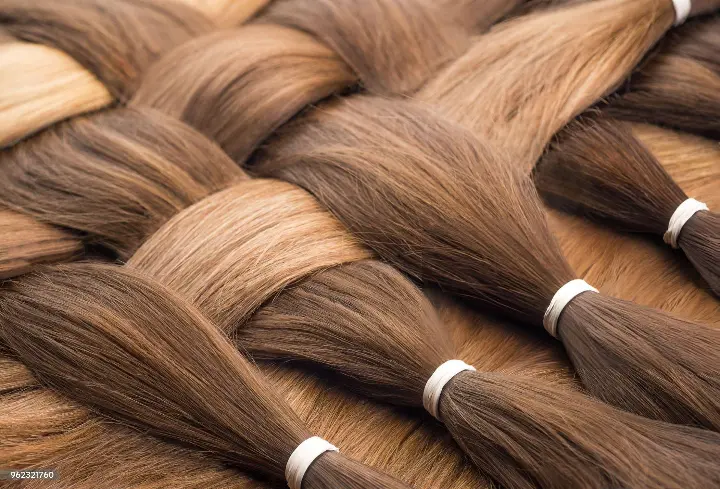Hair extensions have grown in popularity as a beauty accessory since they can change hairstyles and give confidence boosts. However, the market has a wide range of choices, mostly separated into groups for natural and synthetic products. We will examine the price variations between these two hair integration kinds in this blog post, taking into account both the short- and long-term financial effects. We'll also discuss the benefits of investing in natural hair extensions for your appearance and hair health.
Natural vs. Synthetic: Understanding the Basics

Natural Hair Extensions, crafted from human hair, align closely with the inherent properties of real hair, offering a superior match in texture and color. This compatibility ensures that they blend seamlessly with the wearer's natural hair, providing a realistic and aesthetically pleasing look. Unlike synthetic alternatives, which are made from artificial fibers and often restricted by their inability to withstand certain styling techniques, natural extensions can be treated much like one's own hair. They can endure heat styling, washing, and dyeing, which not only allows for a diverse range of hairstyles but also contributes to their longevity. The flexibility to modify their appearance without compromising quality or look makes natural hair extensions a preferred choice for those seeking durable and versatile hair solutions, whereas synthetic extensions, although budget-friendly, offer limited styling choices and tend to have a less natural appearance.
Immediate Costs: Comparing Price Tags
When considering the purchase of hair integrations, the upfront cost is often a decisive factor for many consumers. Natural hair extensions are generally pricier at the outset, primarily because of the meticulous processes they undergo—from ethical sourcing of human hair to extensive processing and rigorous quality assurance procedures that ensure their superior quality and natural appearance. These extensions typically start at about $200 and can escalate to several hundred dollars, influenced by factors such as length, texture, and origin. In contrast, synthetic extensions offer a more economically accessible option, with prices ranging from a modest $20 to around $100. This affordability makes synthetic extensions particularly appealing to those who are looking to enhance their hair aesthetics while adhering to a tighter budget. These cost disparities clearly reflect the differences in the longevity, styling flexibility, and overall quality between natural and synthetic hair integrations.
Long-Term Value: Durability and Maintenance
Synthetic extensions are initially less expensive, but they usually only last two to three months when worn often. This is because they are not resistant to heat or chemical treatments, and they have few styling alternatives. On the other hand, with the right maintenance, natural hair extensions, especially those composed of quality hair, can last a year or longer.
In the long term, natural hair extensions may prove to be a more economical choice due to their lifetime, which may be extended with proper upkeep such as routine cleaning, conditioning, and expert maintenance examinations. Relaxed Straight Hair extensions, for example, are a long-lasting and adaptable alternative because they mirror straightened natural hair and can be fashioned with heat tools to create a variety of appearances.
Styling Options: Flexibility Matters

The styling potential of hair extensions is another issue that affects their cost-effectiveness. Natural hair extensions, like Kinky Curly Hair, mix in perfectly with naturally textured or curly hair to create a range of styles, from twist-outs to wash-and-go appearances. This adaptability may lessen the need for extra style services and hair products, which would lower total expenses.
On the other hand, the style potential of synthetic extensions is restricted. Because coloring is not an option and heat styling is generally discouraged due to the possibility of melting or harming the fibers, they are less adaptable for people who like to switch up their hairstyles frequently.
Aesthetic Appeal: Looking Natural
The decision to invest in hair extensions is often heavily influenced by their aesthetic quality and how seamlessly they blend with one’s natural hair. Natural hair extensions, crafted from human hair, provide a remarkably realistic integration that can enhance the overall appearance and feel of the hair. This seamless integration not only boosts the visual appeal but also proves to be economically beneficial in the long run. Since natural extensions mimic the look and movement of real hair, they can be matched perfectly to the wearer's hair color and texture, reducing the need for additional styling products or accessories that might otherwise be necessary to achieve a cohesive look. The ability to style these extensions with heat tools, just like one's own hair, further adds to their versatility and longevity, making them a valuable choice for those seeking a natural and long-lasting enhancement to their hairstyle.
On the other hand, synthetic hair extensions, while initially more cost-effective and available in a variety of colors and styles, can sometimes detract from the desired natural aesthetic due to their tendency to appear overly shiny or plastic-like. This less natural appearance can be a significant drawback for individuals aiming for a look that closely mimics their natural hair. As a result, wearers of synthetic extensions might find themselves investing additional resources into products or styling services to help these extensions blend more naturally with their own hair. This extra expenditure not only increases the overall cost but can also lead to more time-consuming maintenance routines. Moreover, the inability to apply heat or color treatments limits the versatility of synthetic extensions, potentially leading to further expenses as users seek alternatives to achieve their ideal hairstyle without compromising the look and feel they desire.
Health Benefits: Hair-Friendly Options
Natural hair extensions have significant advantages for hair health that go beyond appearance and cost. Because they are composed of human hair, they blend in seamlessly with real hair, lowering the possibility of breakage or injury. Additionally, they enable natural oils from the scalp to permeate the hair strands, thereby enhancing overall hair health.
However, because synthetic extensions are artificial and don't blend in with the scalp's natural oils, they may break or cause injury. Furthermore, in order to fit in, they frequently need more sophisticated style products or methods, which can exacerbate product buildup and negatively affect hair quality.
Conclusion: Making an Informed Choice
It's important to take into account both the immediate and long-term financial effects when estimating the expense of beauty through hair extensions. Although the initial cost of natural hair extensions may be more, over time, their longevity, adaptability, and ability to mix in flawlessly with natural hair make them an excellent investment. For immediate use, synthetic extensions are less expensive than real hair, but over time, their limited styling options and short lifespan may make them less economical.
For those considering investing in natural hair extensions, we invite you to explore our blog, The Ultimate Guide to Choosing the Right Hair Extensions for Your Natural Hair. This guide provides comprehensive information on selecting the best extensions based on hair type, texture, and desired style, ensuring a successful and satisfying investment. Remember, hair extensions are more than just a beauty accessory—they are a powerful tool to enhance your look, boost confidence, and achieve your desired hairstyle.